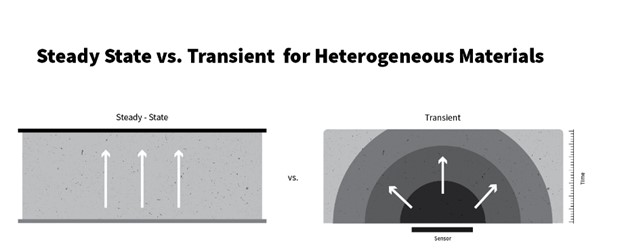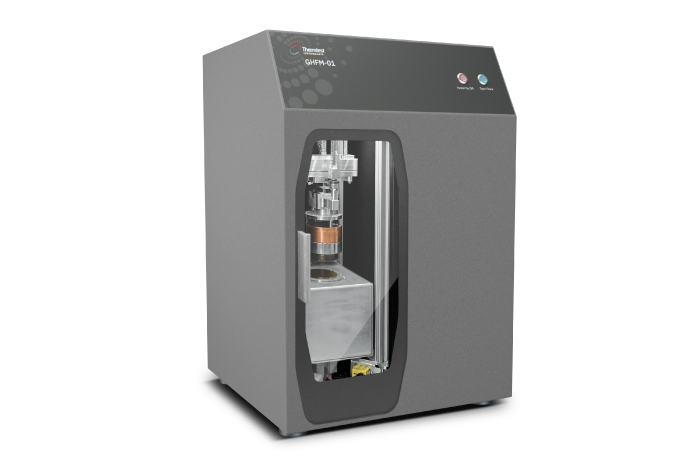When testing the thermal conductivity of non-homogeneous materials like concrete, special care must be taken to measure the true thermal conductivity. Possible methods are typically broken down into two categories: transient and steady-state.
To measure heterogenous samples with traditional transient methods, an optimization of sensor size and test times must be used to test as much of the sample as possible, which is limited to sensor size and test time. Careful considerations to keep the heat penetrating within the boundaries of the sample. Transient methods theory states that heat introduced from the sensor diffuses into the sample by mode of thermal conduction only. Material heterogenous characteristics like pores and particles distort the linear heat flow required for transient measurements, which cannot be corrected in transient calculation models.
Designed for the measurement of homogeneous and heterogeneous materials, standard sample dimensions of 2-inch diameter and thickness up to 1 inch are placed between two plates at a delta temperature of -20 °C to 300 °C. Flux is recorded until steady-state condition is met, which measures thermal resistance across the thickness of the sample. Two specific characteristics make this important for true thermal conductivity.
1. Full thickness – volume is included in thermal resistance/thermal conductivity value.
2. Non-linear heat flow adds errors to transient measurements. Due to steady-state conditions, any non-linear heat flow caused by a non-homogeneous material, do not cause any error for measurement of thermal resistance – thermal conductivity.
A comparison of a volume measured via steady-state (GHFM) vs. transient (TPS) may be seen in the following graphic.

Figure 2: Comparison of volume measured – GHFM vs. TPS
Seen the above figure, when using transient, the time scale used directly determines the volume of the sample measured. It is clear to see that regardless of the time scale selected, it will be impossible to get a full measurement of the sample. In comparison, when a steady state method is used, the full thickness of the sample is considered, and all modes of heat transfer effects are present in the measurement. This makes steady-state (GHFM) a superior choice when measuring heterogenous materials.
The Guarded Heat Flow Meter (GHFM-01) follows ASTM E1530-19 for testing thermal resistance and thermal conductivity of solids, such as metals, polymers, composites and paste from -20 °C to 300 °C. The Thermtest proprietary testing stack, replaces the traditional pneumatic movement with advanced motor control, which allows automated control of testing sample thickness, force or pressure applied.

Figure 1: A portable GHFM-01 that Follows ASTM E1530-19 for thermal conductivity.
The advanced GHFM-01 is a primary measurement of thermal resistance—thermal conductivity for solids, such as metals, polymers, composites, and paste. Specifically, the calculation of thermal conductivity from measurement of thermal resistance is the most accurate method of testing the true thermal conductivity of heterogeneous materials. The steady-state measurement of thermal resistance represents the full sample thickness and mature heat transfer properties.